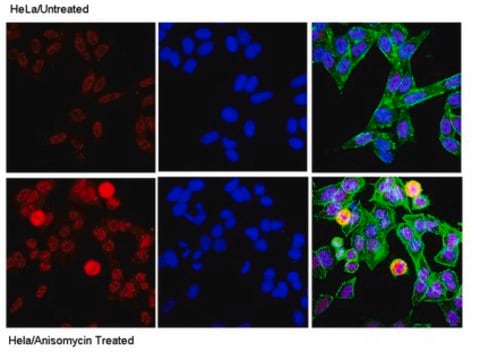ABE24
Anti-BPTF Antibody
from rabbit, purified by affinity chromatography
Synonym(s):
Protein Bptf, Bromodomain PHD-finger Transcription Factor
About This Item
Recommended Products
biological source
rabbit
Quality Level
antibody form
affinity isolated antibody
antibody product type
primary antibodies
clone
polyclonal
purified by
affinity chromatography
species reactivity
mouse, human
technique(s)
immunoprecipitation (IP): suitable
western blot: suitable
NCBI accession no.
shipped in
wet ice
target post-translational modification
unmodified
Gene Information
human ... BPTF(2186)
mouse ... Bptf(207165)
General description
Specificity
Immunogen
Application
Epigenetics & Nuclear Function
Transcription Factors
Western Blotting Analysis: 0.2 µg/mL from a representative lot detected BPTF in 50 µg of wild-type, but not Bptf-knockout, mouse embryonic fibroblast (MEF) lysate (Courtesy of Joseph Landry, Ph.D, Virginia Commonwealth University School of Medicine, U.S.A.).
Immunoprecipitation Analysis: A representative lot co-immunoprecipitated Ctcf and SA2 with BPTF from mouse embryonic stem cell (mESC) extract (Qiu, Z., et al. (2015). Mol. Cell. Biol. 35(1):224-237).
Western Blotting Analysis: A representative lot detected BPTF in Ctcf and SA2 immunoprecipitates from mouse embryonic stem cell (mESC) extract (Qiu, Z., et al. (2015). Mol. Cell. Biol. 35(1):224-237).
Western Blotting Analysis: A representative lot detected BPTF in ESC, MEF, and CD8+/CD4+ double-positive (DP) thymocytes from wild-type, but not Bptf-knockout, mice (Qiu, Z., et al. (2015). Mol. Cell. Biol. 35(1):224-237).
Note: ABE24 is not recommended for Chromatin Immunoprecipitation (ChIP). For ChIP application, please use ABE1966.
Quality
Western Blot Analysis: 0.05 µg/mL of this antibody detected BPTF in 10 µg of NIH/3T3 cell lysate.
Target description
Physical form
Storage and Stability
Analysis Note
NIH/3T3 cell lysate
Other Notes
Disclaimer
Not finding the right product?
Try our Product Selector Tool.
Storage Class
12 - Non Combustible Liquids
wgk_germany
WGK 1
flash_point_f
Not applicable
flash_point_c
Not applicable
Certificates of Analysis (COA)
Search for Certificates of Analysis (COA) by entering the products Lot/Batch Number. Lot and Batch Numbers can be found on a product’s label following the words ‘Lot’ or ‘Batch’.
Already Own This Product?
Find documentation for the products that you have recently purchased in the Document Library.
Our team of scientists has experience in all areas of research including Life Science, Material Science, Chemical Synthesis, Chromatography, Analytical and many others.
Contact Technical Service







